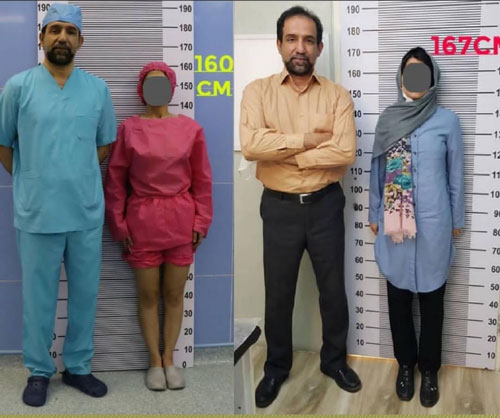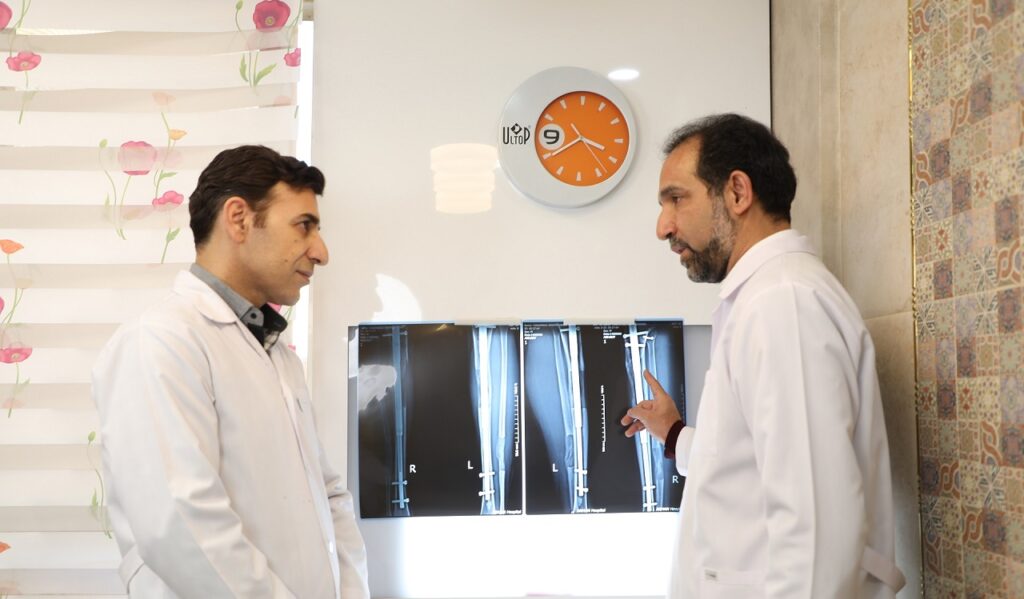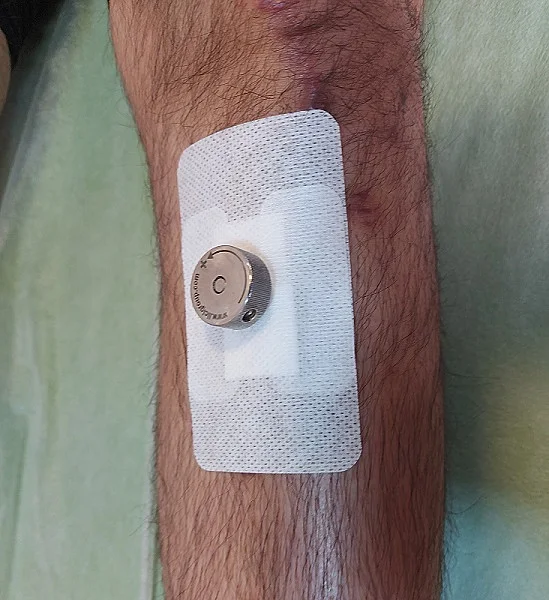Limb Lengthening Surgery
Limb lengthening surgery is the only scientific and practical way to increase people’s height after the closure of growth plates after puberty. At the very beginning, you may have a question, what is a growth plate? We recommend the article “What is a growth plate?” for more information on this issue. Stay with us now to learn more about cosmetic Limb lengthening surgery.
What is limb lengthening surgery?
Limb lengthening surgery, also known as height increase surgery, leg lengthening surgery, or leg extension surgery, is a method to increase the length of the tibia or femur. This work is done gradually so that the size of the bones increases by a maximum of one millimeter a day during the growth stage, as well as the length of the soft tissues (skin, muscles, nerves, etc.), which increases slowly and with the help of physical therapy and stretching exercises. Typically, this process takes several months, depending on your height. We usually increase the length of the femur or tibia at the International Limb lengthening center of IRAN.
Recommended: limb lengthening surgery costs in Iran and other countries.

How does limb lengthening surgery work?
During height increase surgery, the doctor cuts the bone to create two separate bony sections. This surgical method for cutting bone is called an osteotomy. Then the doctor uses an orthopedic device to increase the length of the bone.
In MTN surgery, orthopedic lengthening devices can be placed inside the bone, called internal devices. In LON and LATN methods, orthopedic lengthening devices are placed outside the body, called external fixators.
After the limb lengthening surgery, there will be a recovery period where the bones will rest for five to seven days. This period is called the delay period. After that, the bone-lengthening process begins.
After the delay period, the doctor teaches the orthopedic device to the patient to separate the two bone parts slowly. As the two bony segments slowly separate, new bone forms in the space between them. This new bone increases the overall length of the bone. The new bone is called regenerated bone.
During the growth phase, the patient (or family member) adjusts the device daily to separate the bony parts at a slow rate of approximately 1 mm (0.04 inches) per day. This amount may be slightly different for different bones. For example, the treatment plan may be 0.75 mm per day in the tibia but 1.0 mm per day in the femur or arm. This gradual increase forces the body to constantly build and grow new bones and soft tissues, such as skin, muscles, nerves, and blood vessels. The growth phase continues until the bone reaches the desired length.

Approximately 1 inch (2.5 cm) long can be added per month. The patient should visit the doctor twice a month during the growth phase to ensure that bone length is not increased quickly or slowly. Based on the appearance of bone reconstructed in X-ray photographs, the doctor may accelerate or reduce the speed of bone length. During the growth phase, the patient should receive physiotherapy twice a week.
The growth phase is followed by consolidation, where the regenerated bone slowly hardens. In a typical case of 6 cm (2.5 inches) lengthening, it takes about three months to reach the desired length but another 5 to 6 months for the new bone to harden.
To help improve the construction and growth of bone, patients should avoid nicotine in any form, have a healthy diet with plenty of protein, and consume vitamin supplements and minerals. During the consolidation phase, the doctor advises the patient to start bearing weight (with the help of crutches or a walker), which also stimulates the bone to harden and heal.
If the device is used outside the body to protect more of the new bone, the doctor may use gypsum or ask the patient to use the brace for a while after removing the external fixation. In contrast, when an internal device is removed after increasing the length of the bone, no plaster or split is used.
Limb Lengthening Methods
There are three limb lengthening methods, each chosen according to the person’s physical condition.
- Limb Lengthening by MTN or Manual Telescopic Nail Method
- Limb Lengthening by LON or Lengthening Over Nail Method
- Limb Lengthening by LATN or Lengthening And Then Nailing

How much can each bone be lengthened?
Based on the research and experiences of Dr. Nader Motallebizadeh, which was published in 2014 (source), the preferred increase in bone length is 6 cm.
Usually, a 5 cm and 6 cm height increase is possible with one surgery. At the same time, a 10 cm height increase or up to 12 cm height increase is possible with two height increase surgeries, one in the tibia and the other in the femur.
It should be noted that in the past, the maximum height increase was 7 cm in one surgery and 14 cm in two surgeries. However, according to the 500 limb lengthening surgeries results, Dr. Motallebizadeh has reduced height increase to 6 and 12 cm. The reason for this decision was to reduce the possibility of complications that would lead to additional surgery.
Limb Lengthening Surgery Workflow
The complete steps of limb lengthening surgery and the treatment period are as follows:
Online counseling
Applicants for height increase surgery should register a consultation request through the appointment request form or the WhatsApp and Instagram social networks.
The consultation will be done with Dr. Nader Motallebi-zadeh. He tries to explain to the applicant all the information, including the difficulties, problems, or benefits of height increase surgery. He will advise speaking with patients who have already had limb-lengthening surgery over the phone or in person. The reason for doing this is to reduce the applicant’s stress and to see the result of the surgery performed by the International limb lengthening center of Iran and Dr. Nader Motallebi-zadeh. However, once the counseling process is over, the individual has the opportunity to make a decision.
Basic physical tests
A series of preliminary tests must be performed. In these tests, final measurements are made based on height, weight, and radiology photographs. For example, x-rays should be taken to determine the spread of the bones. The walking posture, the amount of knee deviation, and in general, all physical conditions of the person being tested and checked. Then the necessary equipment is prepared to be sufficient during the operation.
Types of anesthesia and Duration of surgery
Two types of anesthesia are possible for surgery. One type of anesthesia can be local anesthesia from the waist down and the other type is general anesthesia.
Usually, in height increase surgery using the LATN method, the duration of the first operation, which includes osteotomy of both legs and placement of an external fixation device (external fixator), takes about an hour. After the growth period, removing the external fixator and inserting the internal nails takes about two hours and thirty minutes. After that, fiberglass is not needed, unlike the LON limb lengthening surgery.
In MTN limb lengthening surgery, only one operation is needed, which lasts about three hours.
After surgery, pain control and discharge time
After height increase surgery, we try to control the pain with a pump usually used to control pain after surgery, which is a unique device for this purpose (pain control). This device injects strong painkillers continuously and slowly and controls the pain after the operation. I can’t say there will be no pain, but the pain is significantly controlled. Private nurses, private rooms, and amenities are provided for the patient.
The day after the height increase surgery, Dr. Nader Motallebizadeh will visit the patient and check their condition. After a complete examination, walking is allowed. Most people can walk (with the help of a walker, of course) the day after the operation. Usually, the patient stays in the hospital for two to three days.
Post-operative pain is more significant one to two days after surgery than other days during the treatment, and pain decreases by 80-90% on the third and subsequent days. After the patient is discharged from the hospital, certain drugs are given to the patient.
One week after the operation, another appointment is made with the patient in the office, and the height increase starts on the same day. At the same time, the necessary training is given to the patient. Height increase by the MTN method is straightforward. Heightening the MTN method is as simple as turning a screw. It is easier than other methods, such as LON.
The beginning of the growth period
When increasing height has started, the patient is visited once every two weeks, and x-rays are taken to evaluate the process of increasing height and the amount of bone formation.
Physiotherapy starts from the moment of height increase. Physiotherapy is performed three to five times weekly according to the patient’s condition. Physiotherapy and stretching exercises taught to the patient have the most significant effect in reducing pain.
Blood tests are done every two months to check the crucial factors in bone formation. The said things will continue until the end of the height increase period of 6 cm.
At the end of the bone growth period, we remove the height increase screw (in the MTN method). Since the escalation phase is over, the patient is feeling better daily.
5 essential points to control the conditions during the height growth period
During the period of increasing day by day, there is no feeling of improvement, but the patient’s condition will be carefully monitored so that the situation does not worsen. The factors that control these conditions are as follows:
- Regular physical therapy and exercise will be taught to the patient.
- The patient should sleep from 10:30 p.m., which will help build bones.
- Healthy diet,
- Avoiding alcoholic beverages,
- Avoiding smoking,
- Stress control.
Why choose Iran International Center for Limb Lengthening?
Iran’s International center for limb lengthening is known because of its expertise in limb lengthening. Your doctor at the International Center for limb lengthening of Iran will spend time to make sure you understand all your choices and then start your treatment to meet your specific needs. Our patients use our team-centered approach to renowned children’s orthopedic surgeons and adults worldwide and specialist physician assistants, nurses, and physiotherapists. We help patients who need limb lengthening to achieve the best possible results.
Schedule a free consultation with one of our medical experts and begin your journey to increase your height. E-mail us now: info@llcig.com
Is leg lengthening surgery painful?
Post-operative pain is more significant one to two days after surgery than other days during the treatment, but this pain can be controlled and managed, and pain decreases by 80-90% on the third and subsequent days.
How much taller can limb Lengthening make you?
Usually, a 5 cm and 6 cm height increase is possible with one surgery. At the same time, a 10 cm height increase or up to 12 cm height increase is possible with two height increase surgeries, one in the tibia and the other in the femur.
